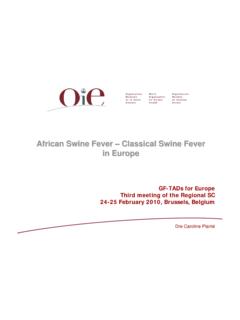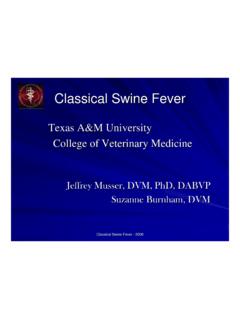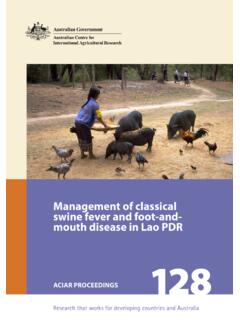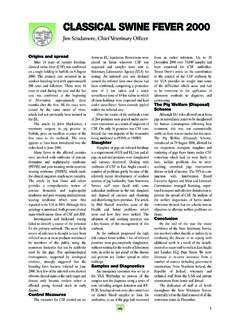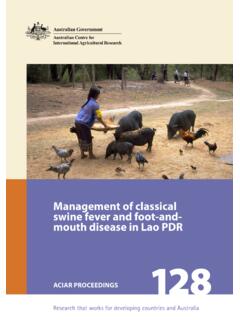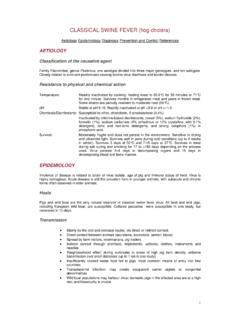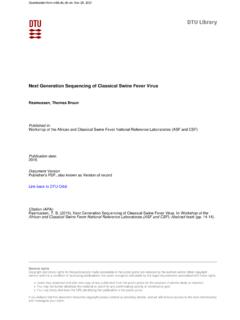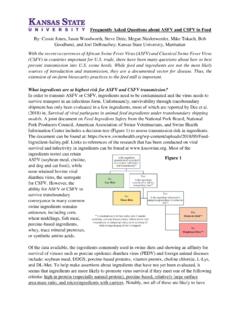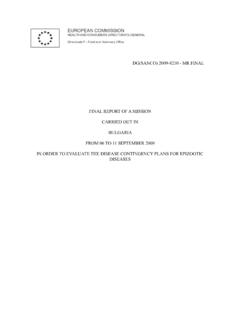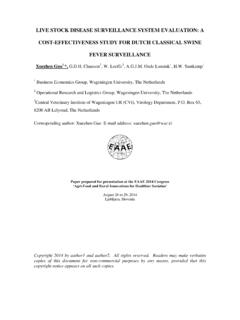Transcription of Swine Disease Global Surveillance Report
1 Swine Disease Global Surveillance Report Worldwide pork production is highly interconnected by trade between countries and markets, which could increase the risk of introduction of foreign pathogens into the US. P R O J E C T The aim of these reports is to have a structure for near real-time identification of hazards that will contribute to the mission of assessing risks to the industry and ultimately, early detection, identification, or prevention of occurrence, in partnership with official agencies, and with our international network of collaborators. Monthly reports are created based on the systematic screening of multiple official data sources, such as government and international organization websites, and soft data sources like blogs, newspapers and unstructured electronic information from around the world then curated to build a raw repository.
2 Afterward, a group of experts use a multi-criteria rubric to score each event, based on novelty, potential direct and indirect financial impacts on the US market, credibility, scale and speed of the outbreak, connectedness, and local capacity to respond from which an average is calculated. The output of the rubric is a final single score for each event which is then published in the Report . Disclaimer: These communications and the information contained therein are for general informational and educational purposes only and are not to be construed as recommending or advocating a specific course of action.
3 UMN Technical Coordination Eliana Paladino1, Auguste Brihn, Sol Perez, Andres Perez2 Expert Focus Group Jerry Torrison, Montserrat Torremorell, Cesar Corzo, Paul Sundberg, John Deen 1 Project coordinator: 2 Principal investigator: Current and previous reports Spontaneous reporting TOOL 2 Swine Disease Global Surveillance Report Bi-monthly Update October 16, 2018 AFRICAN Swine fever ASF Lately there have been no new reports of outbreaks of ASF in new countries, however, Romania, Moldova, Belgium, and China are still being challenged to contain the epidemic.
4 In Europe, wild boars have a main role in the spread of the Disease throughout territories, however, in China it was not yet reported in wild animals - only in backyard and farm animals. CHINA Since last August, 30 outbreaks of ASF have been reported in China spreading through nine provinces (Figure 1). So far in October, seven outbreaks occurred, five of them in the province of Liaoning in the northeast of the country where the first case was reported two months ago. This peak in the number of outbreaks suggests the situation still remains far from under control (Figure 2). Figure 1: Chinese provinces with reported ASF outbreaks, 9 in total: Lianoning, Henan, Jiangsu, Zhejiang, Anhui, Heilongjiang, Inner Mongolia, Jilin, and Tianjin.
5 3 An outbreak in the city of Jinzhou was reported on October 15 by the Ministry of Agriculture and Rural Affairs on its website, affecting the largest farm yet to Report ASF (20,000 pigs) where 221 pigs died from the Disease . This may suggest that the situation in China is continuing to escalate rather than idling. Reuters reported that Beijing Dabeinong Technology Group Co Ltd communicated the information about the outbreak to investors early today (October 16) on an online interactive platform, unfortunately the company could not immediately be reached for further comment.
6 This outbreak has created a significant shift in the general perception that ASF outbreaks in China were limited to small farms with weaker biosecurity and fewer measures to guard against the spread of the Disease . After multiple outbreaks in the cities of Anshan, Panjin, and Jinzhou in Liaoning province, pig prices have significantly decreased after farmers were unable to transport their herds out of infected provinces, while prices in the south have increased. Figure 2: Summary of outbreaks of African Swine fever in China. Twenty-nine outbreaks were reported in 9 provinces. Color code describes outbreaks by month: light red for August; red for September; and dark red for October (Sources: OIE - WAHIS; China Ministry of Agriculture and Rural Affairs).
7 The circle highlights Liaoning province where five outbreaks have been reported in the last week. 4 BELGIUM Belgium keeps investigating the presence of the Disease in the wild boar population. Fences and gates were built aiming to isolate an area, but so far 84 animals were detected positive since the first detection of the Disease in the country, on September 13. There are several theories regarding introduction of the virus in this region in Europe and the role people play in carrying Swine by-products or even hunting materials into this region is being discussed and investigated.
8 classical Swine fever CSF Currently, there are reports of three countries facing challenges of CSF. Russia, Japan, and Brazil recently officially reported cases and measures adopted to control and mitigate risk of spread. Regarding China, it is published in peer-reviewed papers and in the news that the Disease is endemic in the country, however, no official Report was sent to OIE. BRAZIL On October 8, Brazilian Ministry of Agriculture (MAPA) reported an outbreak of CSF in a backyard free-range farm located in the state of Cear (Forquilha-CE). The outbreak was reported to the veterinary service, where high mortality rates and clinical signs (anorexia, fever , incoordination) were observed in sows and younger pigs.
9 The fatality rate was 97 percent and the remaining animals were euthanized. The farm was then isolated followed by the euthanasia for the animals, sanitary destruction of carcasses, disinfection, a restriction of movements in the region, and an initiation of an investigation in surrounding farms. 5 Figure 3: Brazil. In green, zone recognized as free of classical Swine fever by OIE. Red arrow points the location of the outbreak (Forquilha-CE), outside the CSF-free zone. In the detail (smaller map), distribution of the main Swine production in the country in the southern states.
10 Source: Minist rio da Agricultura Pecu ria e Abastecimento (MAPA, Brasil). In 2016, Brazil received the international status of CSF- free zone - see Figure 3, region in green, referring to the southern states, which is also where the main Swine production (~90 percent) is located (south, southeast and midwest). Therefore, the location of the current outbreak is outside the free zone, and the city of Forquilha-CE is 300 miles (500 km) from the border and the free-status will not be affected. The last reported outbreak was in 2009. Currently, the region will be isolated for 12 months, and all the movement between regions is controlled by MAPA to avoid the introduction of the virus in the free zone.

